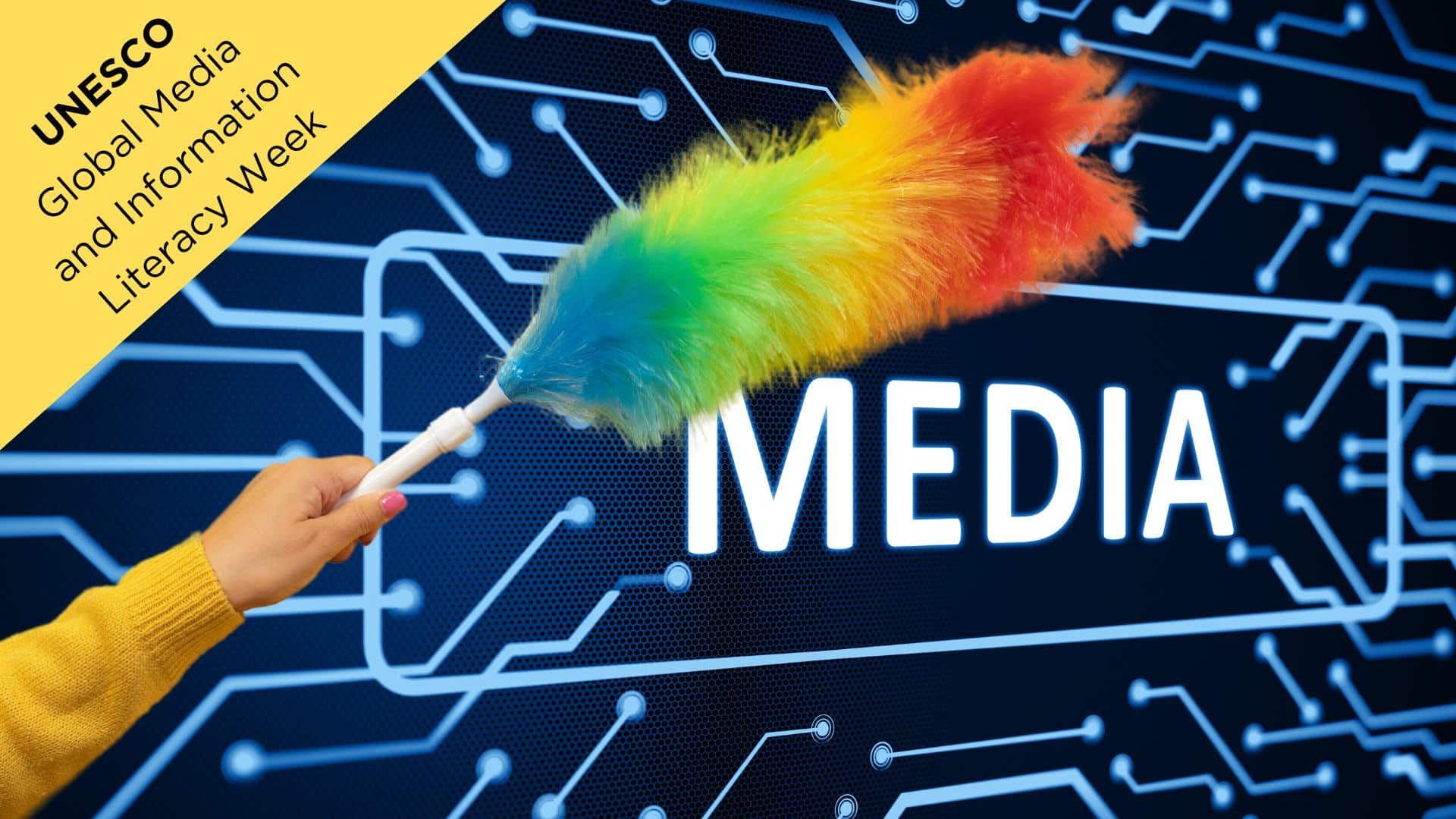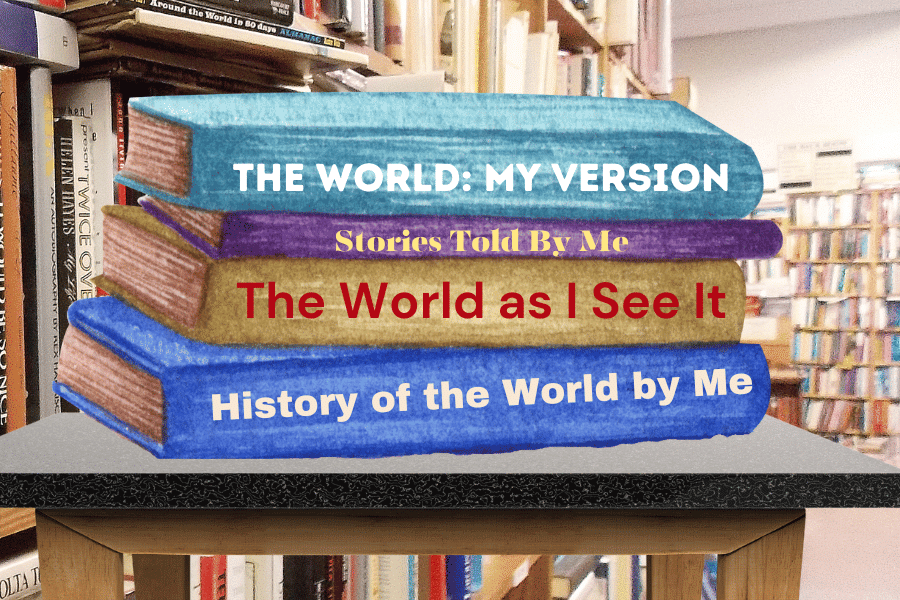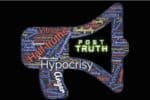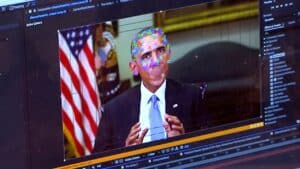Can you spot a deep fake and separate fact from opinion? How do you know what you know? Do you understand how algorithms work? We’ll help you sort it out.

A feather duster over the word media. (Illustration by News Decoder)
From 24 to 31 October, the world marks Global Media and Information Literacy Week, an annual event first launched by UNESCO in 2011 as a way for organizations around the world to share ideas and explore innovative ways to promote Media and Information Literacy for all.
For this year’s theme — “The New Digital Frontiers of Information: Media and Information Literacy for Public Interest Information” — News Decoder presents a series of articles and a Decoder Dialogue webinar on different aspects of media literacy.
We launched this series 24 October with a look at an effort in Finland to make media literacy a core component of primary education. On 25 October we explored the concept of media framing and ways news can shape thought. On 29 October we will look at the role of artificial intelligence in disinformation with an article and a Decoder Dialogue: From Newsrooms to Classrooms: Real Talk About Artificial Intelligence at 18:00 CET, an online roundtable that will bring together experts and students from six countries to talk about fears and hopes for the new technology. We will end the series 30 October with a Decoder Replay of an article that looks at the ramifications of using labels to identify groups of people.
Today we present a collection of articles and media literacy resources to help you become a savvy media consumer.
 How we know about our past and present
How we know about our past and present
Historians dig up stories that document our past the way archeologists sift through relics. The more they learn the more we realize how much we don’t know. Most of what we know was told to us by our parents or schools or religious institutions or popular media, based on information passed down from other people. What we know about our distant past is based on stories told and recorded by a few people who turned out to be historically influential. The mere fact that a story traveled and was preserved gave it power.
 Is this year of elections also the year of deepfakes?
Is this year of elections also the year of deepfakes?
Many people around the world already distrust their election systems. What will happen when artificial intelligence enters the picture? So far in 2024, AI tools have already been used for fake election endorsements, bot comments and spreading calls to boycott elections. Nevertheless, experts say we still rarely see the so-called deepfakes that are indistinguishable from authentic videos or would pose concerning consequences.
 WITW? Your instant message can be a permanent pact
WITW? Your instant message can be a permanent pact
Keeping your word on an agreement is fundamental. But just in case one side tries to renege, you want proof on paper that will hold up in court. But does a casual social media chat count as a contract? That’s the question being debated, as courts around the world start to consider a promise texted via WhatsApp as a contract.
 Can you eliminate your bias from your story?
Can you eliminate your bias from your story?
Journalists are trained to be objective. But what does that mean and where did that idea come from? And is it achievable? In the world of traditional journalism, reporters were supposed to be objective. That meant that they were supposed to report without bias. Objectivity has seemed to all but disappear in the digital age. The thing is, it only became an ethical practice in the 20th century. The idea of objectivity in journalism was born out of a business decision.
 You can handle the truth. But can you verify it?
You can handle the truth. But can you verify it?
Since the 2016 U.S. election, fact-checking has grown into its own dedicated field. Newsrooms sometimes even hire fact-checkers to go over daily stories, feature articles and, especially, investigative stories. According to Duke University’s Reporter’s Lab, fact-checking websites grew from 11 in 2008 to 424 in 2022 worldwide. Fact-checking is a rigorous process that includes going through interview transcripts, reporter’s notes, government documents obtained through freedom-of-information requests and other important materials to make certain a journalistic piece of work is factual and accurate.
 Living in a post-truth world
Living in a post-truth world
Ask an AI app if it will kill off journalism and you get a nuanced answer. But from a human point of view, things seem more black-and-white. The reality is that artificial intelligence could kill journalism without replacing it, leaving people without information they can rely on. When there are no reliable, credible sources of news, rumors spread and take on a life of their own. People panic and riot and revolt based on fears born from misinformation. Lawlessness prevails.
 Selling what we search: How SEO puts products on your pages
Selling what we search: How SEO puts products on your pages
More and more, we seem to get ads related to topics we plug into a search engine — long after we stopped searching that topic.That’s because brands use digital communication strategies, such as search engine rankings and advertisements, to provide users with the most relevant information at the exact moment they’re searching for it.
 ‘News’ is never perfect. But it is necessary in democracies.
‘News’ is never perfect. But it is necessary in democracies.
Who is winning in Ukraine? Who has right on their side? Our answers to these questions will depend on what we’ve been reading, hearing and seeing. In other words, on the various ways in which we pick up “news.” If we see only Russian state media, we will have one set of views. If we get our news from Western newspapers and television, we will have another. Yet there is, in fact, only one series of events happening on the ground in Ukraine. The truth is wrapped in the chaos typical of a war of close combat. It is open to being reported, distorted, interpreted, spun or suppressed in many ways. If we are seriously trying to understand what is going on, how are we to gather and interpret the facts? How do we decode the news?
